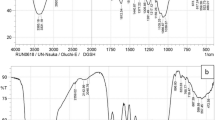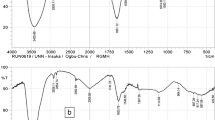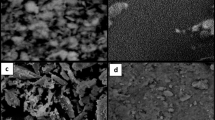Abstract
The potential of raw V. subterranean husks (RVSH) as a novel natural sorbent, and an environmentally friendly and low-cost product for the cleanup of petroleum from contaminated waters was investigated. Characterization of the sorbent was accomplished with scanning electron microscope (SEM), Fourier transform infrared (FTIR), Brunauer–Emmett–Teller (BET) surface area analysis and thermogravimetric analysis (TGA). Batch sorption approach was applied to assess the impact of sorbent dose, pH, initial concentration, temperature as well as time. Crude oil characterization disclosed light oil owing to the oAPI gravity of 36.5°. The Langmuir model offered a superlative fit to the experimental data with greater regression coefficient (R2) and lower chi-square (χ2) and sum of squares of the errors (SSE) contrary to Temkin, Freundlich, Scatchard models and also produced maximum monolayer sorption capacity of 3.79 g/g. The pseudo-second-order model was more appropriate for kinetic considerations than first-order, intraparticle diffusion and liquid film diffusion models, and equilibrium sorption time of 70 min was achieved. Thermodynamic considerations presented an endothermic, non-spontaneous and physicochemical sorption process and also an improvement in randomness of the petroleum-RVSH interface. Recovery was good as 60.58% of the sorbate was salvaged using n-hexane as stripping agent, and reusability of the sorbent was also achieved after each cycle of sorption–desorption analysis. Therefore, the sorbent is suitable in the management of oil-contaminated water bodies.







Similar content being viewed by others
References
Abdelwahab O, Nasr SM, Thabet WM (2017) Palm fibers and modified palm fibers adsorbents for different oils. Alex Eng J 56:749–755
Abdul SG, Taleb HI, Mustafa IK, Yehya E (2015) Application of eggplant peels powder for the removal of oil from produced water. Desalin Water Treat 57(33):15724–15732. https://doi.org/10.1080/19443994.2015.1130661
Akpomie KG, Dawodu FA, Adebowale KO (2015) Mechanism on the sorption of heavy metals from binary solution by a low cost montmorillonite and its desorption potential. Alex Eng J 54:757–767
Akpomie KG, Ezeofor CC, Olikagu CS, Odewole OA, Ezeorah CJ (2018) Abstraction and regeneration potential of temperature enhanced rice husk montmorillonite combo for oil spill. Environ Sci Pollut Res 25(34):34711–34719
Akpomie KG, Ezeofor CC, Ani JU, Eze SI, Odo CC, Onoabedje EA (2019) Equilibrium isotherms modeling of crude oil sorption from aqua mixture onto Codiaeum variegatum stem powder. Petrol Sci Technol 37(3):329–336
Al-Khatib L, Fraige F, Al-Hwaiti M, Al-khashman O (2012) Adsorption from aqueous solution onto natural and acid activated bentonite. Amer J Environ Sci 8(5):510–522
Anirudhan TS, Suchithra PS (2010) Equilibrium, kinetic and thermodynamic modeling for the adsorption of heavy metals onto chemically modified hydrotalcite. Ind J Chem Technol 17:247–259
Annunciado TR, Sydenstricker THD, Amico SC (2005) Experimental investigation of various vegetable fibres as sorbent materials for oil spills. Mar Pollut Bull 50(11):1340–1346
Antony RS, Smart Robin Son DS, Pillai BC, Lindon LR, C. (2011) Parametric studies on pyrolysis of pungam oil cake in electrically heated fluidized bed research reactor. Res J Chem Sci 1:70–80
Azubuike CP, Okhamafe AO (2012) Physicochemical, spectroscopic and thermal properties of microcrystalline cellulose derived from corn cobs. Inter J of Recyl Org Waste in Agric 1(2):67–77
Barka N, Abdennouri M, Makhfouk ME, Qouezal S (2013) Biosorption characteristics of cadmium and lead onto eco-friendly dried cactus (opuntiaficusindica) cladodes. J Environ Chem Eng 1:144–149
Behnood M, Nasernejad B, Nikazar M (2014) Application of experimental design in optimization of crude oil adsorption from saline waste water using raw bagasse. J Cent South Univ 21:684–693
Beyer J, Trannum HC, Bakke T, Hodson PV, Collier TK (2016) Environmental effects of the deepwater horizon oil spill: a review. Mar Pollut Bull 110:28–51
Chiban M, Zerbet M, Carja G, Sinan F (2012) Application of low cost adsorbents for arsenic removal: a review. J Environ Chem Ecotoxi 4:91–102
Chukwuemeka-Okorie HO, Ekemezie PN, Akpomie KG, Olikagu CS (2018) Calcined concob-kaolinite combo as new sorbent for sequestration of toxic metal ions from polluted aqua media and desorption. Front Chem 6:1–13
Dawodu FA, Obioha UN, Akpomie KG (2018) Removal of crude oil from aqueous solution by zinc chloride modified dioscorearotundata peel carbon: equilibrium, kinetic and intraparticle diffusivity. Petrol and Coal 60(3):985–994
Deschamps G, Caruel H, Borredon ME, Bonnin C, Vignoles C (2003) Oil removal from water by selective sorption on hydrophobic cotton fibres: study of sorption properties and comparison with other cotton fibre-based sorbents. Environ Sci Technol 37(5):1013–1015
El-Gendy NS, Nassar HN (2015) Study on the effectiveness of spent waste sugarcane bagasse for adsorption of different petroleum hydrocarbon water pollutants: kinetic and equilibrium isotherm. Desalin Water Treat 57:5514–5528. https://doi.org/10.1080/19443994.2015.1004598
Eze SI, Akpomie KG, Ezeofor CC, Mmadubuike NV, Ojo FK (2019) Remediation of oil spill polluted water from Niger Delta Nigeria by sorption onto ammonium sulfate modified Dialiumguineenseseed husk. Petrol Sci Technol. https://doi.org/10.1080/10916466.2019.1608240
Farah JY, El-Gendy NS (2013) Performance kinetics and equilibrium in biosorption of anionic dye acid red 14 by the waste biomass of saccharomyces cerevisiae as a low cost biosorbent. Turk J Eng Environ Sci 37:146–161
Fathy M, El-Sayed M, Ramzi M, Abdelraheem OH (2017) Adsorption separation of condensate oil from produced water using ACTF prepared of oil palm leaves by batch and fixed bed techniques. Egypt J Petrol. https://doi.org/10.1016/j.ejpe.2017.05.005
Foo KY, Hameed BH (2010) Insight into the modeling of adsorption isotherm systems. Chem Eng J 156:2–10
Guler UA, Sarioglu M (2013) Single and binary biosorption of Cu(II), Ni(II) and methylene blue by raw and pretreated Spirogyrasp: equilibrium and kinetic modeling. J Environ Chem Eng 1(3):369–377
Gulistan AS, Ibrahim TH, Khamis MI, Elsayed Y (2015) Application of egg plants peels powder for the removal of oil from produced water. Desalin Water Treat 57:15724–15732. https://doi.org/10.1080/19443994.2015.1130661
Ifelebuegu AO, Nguyen TVA, Ukotije-Ikwut P, Momoh Z (2015) Liquid-phase sorption characteristics of human hair as a natural oil spill sorbent. J Environ Chem Eng 3(2):938–943
Igberase E, Osifo P, Ofomaja A (2014) The adsorption of Cu (II) ions by polyaniline grafted chitosan beads from aqueous solution: equilibrium, kinetic and desorption studies. J Environ Chem Eng 2:362–369
ITOPF 2016. The international tanker owners’ pollution federation limited oil tanker spill statistics 2015. Retrieved March 16, 2016
Karan CP, Rengasamy RS, Das D (2011) Indian clean up by structured fiber assembly. Ind J Fiber Texti Res 36:190–200
Li Y, Xia B, Zhao Q, Liu F, Zhang P, Du Q, Wang D, Li D, Xia WZ, Y (2011) Removal of copper ions from aqueous solution by calcium alginate immobilized kaolin. J Environ Sci 23(3):404–411
Liang S, Guo X, Feng N, Tian Q (2010) Isotherms, kinetics and thermodynamic studies of adsorption of Cu2+ from aqueous solution by Mg2+/K+ orange peel adsorbents. J Hazard Mater 174:756–762
Mansour MT, Aqsha A, Mahinpey N (2016) Development of oil-spill sorbent from straw biomass waste: experiments and modeling studies. J Environ Managt 171:166–176
Meitei MD, Prasad MNV (2013) Pb(II) and Cd(II) biosorption on spirodela polyhiza Scheleiden biomass. J Environ Chem Eng 1:200–207
Moussavi G, Bagheri A (2012) Removal of petroleum hydrocarbon from contaminated groundwater by the combined techniques of adsorption onto perlite followed by the O3/H2O2 process. Environ Technol 33(16):1905–1919. https://doi.org/10.1080/09593330.2011.650223
Nessim RB, Bassioung AR, Zaki HR, Moawad MN, Kandeel KM (2011) Biosorption of Pb and Cd using marine algae. Chem Ecolo 27(6):579–594
Nuhoglu Y, Malkoc E (2009) Thermodynamics and kinetic studies for environmentally friendly Ni(II) biosorption using waste pomace of olive oil factory. Bioresour Technol 100:2375–2380
Nwadiogbu JO, Ajuwe VIE, Okoye PAC (2016) Removal of crude oil from aqueous medium by sorption on hydrophobic concorbs. Equilibrium and kinetic studies. J Taibah Uni Sci 10:56–63
Okiel K, El-sayed M, El-kady MY (2011) Treatment of oil water emulsions by adsorption onto activated carbon, bentonite and deposited carbon. Egypt J Pet 20:9–15
Sabir S (2015) Approach of cost-effective adsorbents for oil removal from oily water. Crit Rev Environ Sci Technol 45(17):1916–1945
Saruchi KBS, Jindal R, Kumar V (2015) The adsorption of crude oil from an aqueous solution using a gum tragacanth polyacrylic acid based hydrogel. Petrol Sci Technol 33:278–286
Sokker HH, El-sawy NM, Hassan MA, El-Anadouli BE (2011) Adsorption of crude oil from aqueous solution by hydrogel of chitosan based polyacrylamide prepared by radiation induced graft polymerization. J Hazard Mater 190:359–365
Sun XF, Sun RC, Sun JX (2004) Acetylation of sugarcane bagasse using NBS as a catalyst under mild reaction conditions for the production of oil sorption-active materials. Bioresour Technol 95(3):343–350
Teli MD, Valia SP (2013) Application of modified coir fiber as eco-friendly oil sorbent. J Fashion Technol Text Eng 1(1):1–5
Teli MD, Valia SP, Mifta J (2016) Application of Functionalized Coir Fibre as Eco-Friendly Oil Sorbent. J Text Inst. https://doi.org/10.1080/00405000.2016.1220048
Zou J, Chai W, Liu X, Li B, Zhang X, Yin T (2015) Magnetic pomelo peel as a new absorption material for oil-polluted water. Desalin Water Treat 57(27):12536–12545
Acknowledgements
I am indebted to the personnel of Materials and Energy Technology Department, Projects Development Institute (PRODA), Enugu, as well as Physics Department, Federal University of Technology, Minna, for using their facilities.
Funding
The authors did not receive support from any organization for the submitted work.
Author information
Authors and Affiliations
Contributions
Ikeokwu Chris Ogbu contributed to conceptualization, methodology, investigation, data curation, writing–original draft preparation, reviewing and editing. Cynthia Nkolika Ibeto contributed to conceptualization, writing–reviewing and editing, supervision. Chukwuma Obiajulu B. Okoye contributed to supervision.
Corresponding author
Ethics declarations
Conflict of interest
The authors have no conflicts of interest to declare that are relevant to the content of this article.
Additional information
Editorial responsibility: Sivakumar Durairaj.
Rights and permissions
About this article
Cite this article
Ogbu, I.C., Ibeto, C.N. & Okoye, C.O.B. Application of raw Vigna subterranean husks as novel sorbent for abstraction of petroleum from contaminated waters. Int. J. Environ. Sci. Technol. 19, 4869–4882 (2022). https://doi.org/10.1007/s13762-021-03447-3
Received:
Revised:
Accepted:
Published:
Issue Date:
DOI: https://doi.org/10.1007/s13762-021-03447-3




